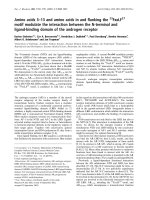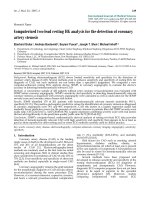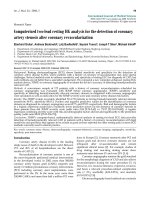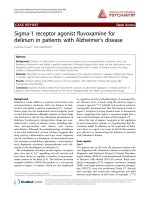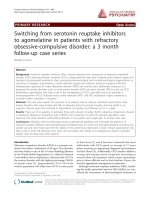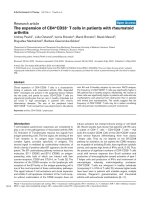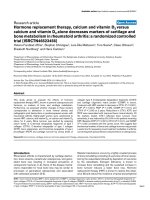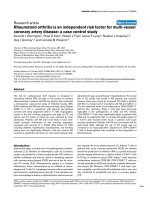Báo cáo y học: "Trace Elements, Heavy Metals and Vitamin Levels in Patients with Coronary Artery Diseas"
Bạn đang xem bản rút gọn của tài liệu. Xem và tải ngay bản đầy đủ của tài liệu tại đây (357.59 KB, 5 trang )
Int. J. Med. Sci. 2011, 8
456
I
I
n
n
t
t
e
e
r
r
n
n
a
a
t
t
i
i
o
o
n
n
a
a
l
l
J
J
o
o
u
u
r
r
n
n
a
a
l
l
o
o
f
f
M
M
e
e
d
d
i
i
c
c
a
a
l
l
S
S
c
c
i
i
e
e
n
n
c
c
e
e
s
s
2011; 8(6):456-460
Research Paper
Trace Elements, Heavy Metals and Vitamin Levels in Patients with Coronary
Artery Disease
Aysegul Cebi
1
, Yuksel Kaya
2
, Hasan Gungor
3
, Halit Demir
4
, Ibrahim Hakki Yoruk
4
, Nihat Soylemez
2
,
Yilmaz Gunes
5
, Mustafa Tuncer
5
1. Giresun University Faculty of Health Sciences, Giresun, Turkey
2. Yuksek Ihtisas Training and Research Hospital, Department of Cardiology, Van, Turkey
3. Mus State Hospital, Department of Cardiology, Mus, Turkey
4. Yuzuncu Yil University Faculty of Science, Department of Chemistry, Van, Turkey
5. Yuzuncu Yil University, Faculty of Medicine, Department of Cardiology, Van, Turkey
Corresponding author: Aysegul Cebi, PhD, Giresun University Faculty of Health Sciences, Piraziz/Giresun, Turkey. Tel:
+90.454.3613788, Fax: +90.454.3613544, e-mail:
© Ivyspring International Publisher. This is an open-access article distributed under the terms of the Creative Commons License (
licenses/by-nc-nd/3.0/). Reproduction is permitted for personal, noncommercial use, provided that the article is in whole, unmodified, and p roperly cited.
Received: 2011.05.12; Accepted: 2011.07.25; Published: 2011.08.02
Abstract
Aim: In the present study, we aimed to assess serum concentrations of zinc (Zn), copper
(Cu), iron (Fe), cadmium (Cd), lead (Pb), manganese (Mn), vitamins A (retinol), D (cho-
lecalciferol) and E (α-tocopherol) in patients with coronary artery disease (CAD) and to
compare with healthy controls.
Methods: A total of 30 CAD patients and 20 healthy subjects were included in this study.
Atomic absorption spectrophotometry (UNICAM-929) was used to measure heavy metal
and trace element concentrations. Serum α-tocopherol, retinol and cholecalciferol were
measured simultaneously by high performance liquid chromatography (HPLC).
Results: Demographic and baseline clinical characteristics were not statistically different
between the groups. Serum concentrations of retinol (0.3521±0.1319 vs. 0.4313±0.0465
mmol/I, p=0.013), tocopherol (3.8630±1.3117 vs. 6.9124±1.0577 mmol/I, p<0.001), chole-
calciferol (0.0209±0.0089 vs. 0.0304±0.0059 mmol/I, p<0.001) and Fe (0.5664±0.2360 vs.
1.0689±0,4452 µg/dI, p<0.001) were significantly lower in CAD patients. In addition,
while not statistically significant serum Cu (1.0164±0.2672 vs. 1.1934±0.4164 µg/dI,
p=0.073) concentrations were tended to be lower in patients with CAD, whereas serum
lead (0.1449±0.0886 vs. 0.1019±0.0644 µg/dI, p=0.069) concentrations tended to be higher.
Conclusions: Serum level of trace elements and vitamins may be changed in patients
with CAD. In this relatively small study we found that serum levels of retinol, tocopher-
ol, cholecalciferol, iron and copper may be lower whereas serum lead concentrations may
be increased in patients with CAD.
Key words: coronary artery disease; trace element; heavy metal; vitamin
INTRODUCTION
Coronary artery disease (CAD) is a leading cause
of morbidity and mortality in developed countries
and is emerging as an epidemic in developing coun-
tries (1). Traditional risk factors such as serum cho-
lesterol, blood pressure and smoking account for not
more than 50% of CAD mortality (2). There is strong
evidence that oxidative free radicals have a role in the
development of degenerative diseases including CAD
Ivyspring
International Publisher
Int. J. Med. Sci. 2011, 8
457
(3). Oxidative free radicals increase the peroxidation
of low density lipoprotein (LDL) thereby increasing
its uptake by macrophages with increased foam cell
formation and atherosclerosis, though other mecha-
nisms may exist (4). Each antioxidant has different
and important mechanisms of action since oxidative
damage can be caused by lipid- or water-soluble
molecules. Lipid-soluble antioxidants are likely to be
very important in preventing the peroxidation of LDL
and this action could be paramount in the prevention
of atherosclerosis. As lypophilic molecules, vitamin E
and beta-carotene are incorporated into the LDL par-
ticle. Vitamin E plays an essential protective role
against free radical damage
(5). Previous experimental
and epidemiologic evidence suggested that some an-
tioxidant vitamins appear to be important in reducing
the risk of CAD
(6).
Studies on the roles of trace elements in health
and disease over the past 50 years have led to a good
understanding of their mode of action and why they
are essential to life
(7). Some studies have assessed the
association between iron status and CAD risk but the
results have been inconsistent
(8,9).
The aim of the present study was to investigate
the changes occurring in the serum level zinc (Zn),
copper (Cu), iron (Fe), cadmium (Cd), lead (Pb),
manganese (Mn), vitamins A (retinol), D (cholecalcif-
erol) and E (α-tocopherol) in patients with CAD.
MATERIALS AND METHODS
The study population included 30 patients hav-
ing angiographically demonstrated CAD and 20 pa-
tients having normal coronary arteries attending car-
diology clinic at Yuzuncu Yil University Hospital. The
study was approved by the local ethics committee
according to the declaration of Helsinki, and patients
gave written informed consent.
Sample Collection And Analysis
Blood samples were collected into tubes without
coagulant. Serum was obtained by centrifugation at
2500 rpm for 15 minutes and stored at −80°C until
assayed. Serum α-tocopherol, retinol and cholecalcif-
erol were measured simultaneously by high perfor-
mance liquid chromatography (HPLC)
(10-12). Serum
concentrations of Zn, Cu, Fe, Cd, Pb and Mn were
determined by Atomic Adsorption Spectrophotome-
ter.
Statistical Analysis
Data were presented as mean±standard devia-
tion (SD). Using SPSS package 16.0 (SPSS Inc. Chica-
go, IL, USA), data between the groups were compared
with Student’s t test for continuous variables and
chi-square t-test for continuous variables.
Mann-Whitney’s U-test was used for variables with-
out normal distribution. A two-tailed P-value of <0.05
was considered significant.
RESULTS AND DISCUSSION
Clinical characteristics and serum cholesterol
levels were not significantly different in patients with
and without CAD (Table 1). Comparisons of the levels
of the vitamins (retinol, tocopherol and cholecalcifer-
ol), and trace elements and heavy metals (Zn, Cu, Fe,
Cd, Pb and Mn) in patients with CAD and the control
group are shown in Table 2. Compared with the con-
trol group, serum concentrations of retinol, tocopher-
ol, cholecalciferol and iron were significantly lower in
patients with CAD.
Table 1: Clinical characteristics of study population.
Patients with CAD
(n=30)
Control group
(n=20)
P-value
Age (years) 59.1±10.6 57.5±9.9 0.613
BMI (kg/m
2
) 29.0396±4.0172 27.9001±3.5504 0.309
Smoking (%) 19 (% 63.3) 11 (% 55) 0.383
Hypertension (%) 19 (% 63.3) 7 (% 35.0) 0.082
Diabetes mellitus (%) 13 (% 43.3) 5 (% 25.0) 0.237
Total cholesterole (mg/dl) 184.5±40.2 203.7±37.8 0.120
Triglyceride (mg/dl) 200.8±96.4 177.8±52.8 0.572
LDL cholesterol (mg/dl) 120.5±20.8 133.0±28.6 0.178
HDL cholesterol (mg/dl) 39.4±7.5 42.7±10.0 0.331
Creatinine (mg/dl) 0.85±0.17 0.87±0.21 0.849
BMI: body mass index, HDL: High Density Lipoprotein, LDL: Low Density Lipoprotein
Data is presented as mean ±SD.
Int. J. Med. Sci. 2011, 8
458
Table 2: Serum levels of vitamins and trace elements in study population.
Patients with CAD
(n=30)
Control group
(n=20)
P value
Retinol (mmol/I) 0.3521±0.1319 0.4313±0.0465 0.013
Tocopherol (mmol/I) 3.8630±1.3117 6.9124±1.0577 <0.001
Cholecalciferol (mmol/I) 0.0209±0.0089 0.0304±0.0059 <0.001
Fe (µg/dI) 0.5664±0.2360 1.0689±0,4452 <0.001
Mn (µg/dI) 0.0606±0.0558 0.0429±0.0638 0.304
Pb (µg/dI) 0.1449±0.0886 0.1019±0.0644 0.069
Cu (µg/dI) 1.0164±0.2672 1.1934±0.4164 0.073
Cd (µg/dI) 0.0070±0.0046 0.0087±0.0060 0.282
Zn (µg/dI) 0.8514±0.5522 0.9087±0.1833 0.657
Cd: cadmium , Cu: copper, Fe: iron, Mn:manganese, Pb: lead, Zn: zinc
Data is presented as mean ±SD.
In this study, we found that serum concentra-
tions of retinol, tocopherol, cholecalciferol and Fe
were significantly decreased in patients with CAD. In
addition, while not statistically significant, serum Cu
concentrations tended to be lower in patients with
CAD, whereas serum Fe concentrations tended to be
higher.
CAD has been associated with several risk fac-
tors including family history, age, elevated blood
cholesterol, diabetes mellitus, cigarette smoking and
hypertension
(13). Several trace elements have also
been implicated in the pathogenesis of CAD
(14). Low
serum Zn levels have been associated with increased
cardiovascular mortality
(14). The results of the pre-
sent study show that serum Zn concentrations were
significantly lower in the control group. Lower Zn
levels in CAD may be a cause or a result of another
unknown parameter. Lukaski et al. (1988)
observed a
slight increase in serum Cu and a signficant increase
in urine Cu levels in patients suffering from myocar-
dial infarction (MI) (15). Reunanen et al. (1996) found
increased levels of serum Cu in patients with CAD
(14). In contrast, in our study, the serum Cu concen-
trations tended to be lower in patients with CAD.
Epidemiological investigations that associate
body Fe stores with CAD risk have produced con-
flicting results; these may in part be explained by the
use of nonspesific measures of body Fe stores, such as
serum transferrin
(16-19). The strongest supporting
evidence that Fe is a risk factor for CAD stems from a
cohort study of eastern Finnish men, in which high
levels of serum ferritin and dietary Fe intake were
positively associated with the incidence of myocardial
infarction. Ascherio et al. (1994) reported an increased
risk of nonfatal MI or fatal CAD with Fe intake (17).
Sullivan et al. (1981)
proposed that depletion of body
Fe stores reduced the risk of CAD (16). Most subse-
quent prospective studies investigating whether Fe
status or dietary Fe intake is associated with an in-
creased risk of MI or CAD have not supported the
hypothesis that high body Fe stores increase the risk
of CAD (20,21,18). Accordingly, we found signifi-
cantly lower serum iron levels in patients with CAD.
Because of its possible role in preventing heart
disease researchers have taken interest in fat-soluble
tocopherol. Recent studies have suggested that
α-tocopherol supplementation can help reduce the
incidence of coronary disease (1,22). However, a large
prospective study found no benefit of tocopherol
supplemantation in preventing CAD. Levels of to-
copherol were reported to be decreased in coronary
artery disease (23).Our results also demonstrate that
serum tocopherol levels were lower in CAD patients
compared to controls.
As far as we know, there is no study examining
serum Cd levels in CAD in the literature. We have
found that serum Cd levels were significantly de-
creased in CAD. Therefore, the significance of this
finding should be further analysed in larger studies.
Mn is an element essential for health in trace
amounts, but toxic at higher levels. There are a few
reports in the literature examining the effects of excess
oral exposure of humans to Mn. The urine of CAD
patients also shows higher Mn concentrations than
that of healthy controls (24). In atherosclerotic sub-
jects, the Mn content of the heart and aorta of athero-
sclerotic subjects is lower and plasma levels are higher
than in healthy controls
(25-27). This increase is so
rapid and specific that it may be used as a diagnostic
indicator of a recent MI. In the present study however,
Mn concentrations were not significantly increased in
patients with CAD.
Blood Pb level was not found to be associated
with coronary heart disease incidence
(28). The car-
diovascular effects of Pb have been associated with
increased blood pressure and hypertension. Studies in
Int. J. Med. Sci. 2011, 8
459
general populations have identified a positive associ-
ation of Pb exposure with clinical cardiovascular,
CAD and stroke mortality; and peripheral arterial
disease, but the number of studies is small (29,30).
Numerous experimental studies in animals have
shown irrefutable evidence that chronic exposure to
low Pb levels results in arterial hypertension that
persists long after the cessation of Pb exposure
(29).
We couldn’t found information about Pb levels
among patients with CAD having no history of Pb
exposure in literature. In the present study, it was
found that mean levels of serum Pb tended to be
higher in CAD patients.
We found that mean values for retinol were sig-
nificantly lower in patients with CAD compared to
the control group. Other investigators have also re-
ported decreased retinol levels in patients with CAD
(31,32). In other studies, Levels of retinol were similar
in patients with CAD compared to controls (5,6,31,32).
Numerous studies have explored whether retinol
supplements can help to prevent cardiovascular dis-
eases. Results of large randomized controlled trials of
the impact of antioxidant vitamin supplements have
been ambiguous or contradictory (33). The current
evidence does not support indiscriminate use of reti-
nol to prevent or to reduce CAD
(4,33).
Similar to results reported in previous studies,
we found serum cholecalciferol levels to be lower in
CAD. Cholecalciferol deficiency is associated with
increased cardiovascular risk, above and beyond es-
tablished cardiovascular risk factors
(34,35). Several
mechanisms may explain the link between cholecal-
ciferol deficiency and cardiovascular disease. Clinical
studies have reported cross-sectional associations
between lower cholecalciferol levels and plasma renin
activity, blood pressure, coronary artery calcification
and prevalent cardiovascular disease (36-41).
In conclusion, serum levels of trace elements and
vitamins may be changed in patients with CAD. The
higher or lower levels may be both a cause and effect
of atherosclerosis or the result of another unknown
parameter. In this relatively small study we found
that serum levels of retinol, tocopherol, cholecalcifer-
ol, Fe and Cu may be lower whereas serum Pb con-
centrations may be increased in patients with CAD.
These findings need to be further investigated in
larger well designed studies.
Conflict of Interest
The authors have declared that no conflict of in-
terest exists.
References
1. Yusoff K. Vitamin E in cardiovascular disease: Has the diet
been cast? Asia Pac J Clin Nutr. 2002; 11: 443-447.
2. Gey KF, Puska J, Jordon P, et al. Inverse correlation between
plasma vitamin E and mortality from ischemic heart disease in
cross-cultural epidemiology. Am J Clin Nutr. 1991; 53: 326-334.
3. Ames BN, Shigenaga MK, Hagen TM. Oxidants, antioxidants,
and the degenerative diseases of aging. Proc Natl Acad Sci.
1993; 90: 7915–7922.
4. Steinberg D. Anti-oxidant vitamins and coronary heart disease.
N Engl J Med. 1993; 328: 1487–1489.
5. Marchioli R. Antioxidant vitamins and prevention of cardio-
vascular disease: laboratory, epidemiological and clinical trial
data. Pharmacol Res. 1999; 40: 227-238.
6. Adams AK, Wermuth EO, Mcbride PE. Antioxidant vitamins
and the prevention of coronary heart disease. Am Fam Physi-
cian. 1999; 60: 895-904.
7. Yavuz B, Ertugrul DT, Cil H, et al. Increased Levels of 25 Hy-
droxyvitamin D and 1,25-Dihydroxyvitamin D After Rosuvas-
tatin Treatment: A Novel Pleiotropic Effect of Statins? Cardio-
vasc Drugs Ther. 2009; 20: 312-320.
8. Tuomainen TP, Punnonen K, Nyyssonen K, et al. Association
between body iron stores and the risk of acute myocardial in-
farction in men. Circulation. 1998; 97: 1461-1466.
9. Danesh J, Appleby P. Coronary heart disease and iron status:
meta-analyses of prospective studies. Circulation. 1999; 99:
852-854.
10. Miller KW and Yang CS. An Isocratic High-Performance Liquid
Chromatography Method for the Simultaneous Analysis of
Plasma Retinol, α-tocopherol and Various Carotenoids. Anal
Biochem. 1985; 145: 21-26.
11. Zaspel BJ, and Csallany S. Determination of Alpha-Tocopherol
in Tissues and Plasma by High-Performance Liquid Chroma-
tography. Anal Biochem. 1983; 130: 146-150.
12. Reynolds SL and Judd HJ. Rapid Procedure for the Determina-
tion of Vitamins A and D in Fortified Skimmed Milk Powder
Using High-Performance Liquid Chromatography. Anal Bio-
chem. 1984; 109: 489-492.
13. Kagan A, Kannel WB, Dawber TR, et al. The coronary profile.
Ann Ny Acad Sci. 1963; 97: 883-894.
14. Reunanen A, Knekt P, Marniemi J, et al. Serum calcium, mag-
nesium, copper and zinc and risk of cardiovascular death. Eur J
Clin Nutr. 1996; 50: 431–437.
15. Lukaski HC, Klevay LM, Milne DB. Effects of dietary copper on
human autonomic cardiovascular function. Eur J Appl Physiol.
1988; 58: 74–80.
16. Sullivan JL. Iron and the sex difference in heart disease risk.
Lancet. 1981; 1: 1293–1294.
17. Ascherio A, Willett WC, Rimm EB, et al. Dietary iron intake and
risk of coronary disease among men. Circulation. 1994; 89:
969–974.
18. Sempos CT, Looker AC, Gillum RF, et al. Body iron stores and
the risk of coronary heart disease. N Engl J Med. 1994; 330:
1119–1124.
19. Ascherio A, Willett WC, Rimm EB, et al. Blood donations and
risk of coronary heart disease in men. Circulation. 2001;103:
52-57.
20. Reunanen A, Takkunen H, Knekt P, et al. Body iron stores,
dietary iron intake and coronary heart disease mortality. J In-
tern Med. 1995; 238: 223-230.
21. Liao Y, Cooper RS, McGee DL. Iron status and coronary heart
disease: negative findings from the NHANES I epidemiologic
follow-up study. Am J Epidemiol. 1994; 139: 704-712.
22. Rimm EB, Stampfer MJ, Ascherio A, et al. Vitamin E consump-
tion and the risk of coronary heart disease in men. N Engl J
Med. 1993; 328: 1450-1456.
Int. J. Med. Sci. 2011, 8
460
23. Lonn E, Bosch J, Yusuf S, et al. Effects of long-term vitamin E
supplementation on cardiovascular events and cancer: a ran-
domized controlled trial. JAMA. 2005; 293:1338-47.
24. Kanabrocki EL, Scheving LE, Olwin JH, et al. Circadian varia-
tion in the urinary excretion of electrolytes and trace elements
in men. Am J Anat. 1983; 166: 121-148.
25. Volkov NF. The cobalt, manganese and zinc content in the
blood and internal organs of atherosclerotic patients. Ter Arkh.
1962; 34: 52-56.
26. Bala IuM, Plotko SA, Furmenko G. Content of manganese,
nickel, zinc, copper, silver and lead in the blood, aorta, liver,
kidneys and pancreas of atherosclerotic patients. Ter Arkh.
1967; 39: 105-111.
27. Masironi R. Trace elements and cardiovascular diseases. Bull
World Health Organ. 1969; 40: 305–312.
28. Kromhout D. Blood lead and coronary heart disease risk among
elderly men in Zutphen the Netherlands. Environ Health Per-
spect. 1988; 78: 43-46.
29. Navas-Acien A, Guallar E, Silbergeld EL, et al. Lead Exposure
and Cardiovascular Disease—A Systematic Review. Environ
Health Perspect. 2007; 115: 472-482.
30. Lustberg M, Silbergeld E. Blood lead levels and mortality. Arch
Intern Med. 2002; 162: 2443-2449.
31. Rock E, Winklhofer-Roob BM, Ribalta J, et al. Vitamin A, vita-
min E and carotenoid status and metabolism during ageing:
functional and nutritional consequences (VITAGE PROJECT).
Nutr Metab Cardiovasc Dis. 2001; 11: 70-73.
32. Omenn GS, Goodman GE, Thornquist MD, et al. Effects of
acombination of β-carotene and vitamin A on lung cancer and
cardiovascular disease. NEJM. 1996; 334: 1150-1155.
33. Riccioni G, Bucciarelli T, Mancini B, et al. Antioxidant Vitamin
Supplementation in Cardiovascular Diseases. Ann Cli Lab Sci.
2007; 37: 12-16.
34. Malabanan A, Veronikis IE, Holick MF. Redefining vitamin D
insufficiency. Lancet. 1998; 351: 805–806.
35. Wang TJ, Pencina MJ, Booth SL, et al. Vitamin D Deficiency and
Risk of Cardiovascular Disease. Circulation. 2008; 117: 503-511.
36. Carrie W, Nemerovski PD, Michael P, et al. Vitamin D and
Cardiovascular Disease. Pharmacotherapy. 2009; 29: 691-708.
37. Lind L, Hanni A, Lithell H, et al. Vitamin D is related to blood
pressure and other cardiovascular risk factors in middle-aged
men. Am J Hypertens. 1995; 8: 894–901.
38. Watson KE, Abrolat ML, Malone LL, et al. Active serum vita-
min D levels are inversely correlated with coronary calcifica-
tion. Circulation. 1997; 96: 1755–1760.
39. Doherty TM, Tang W, Dascalos S, et al. Ethnic origin and serum
levels of 1,25-dihydroxyvitamin D3 are independent predictors
of coronary calcium mass measured by electron-beam com-
puted tomography. Circulation. 1997; 96: 1477–1481.
40. Scragg R, Jackson R, Holdaway IM, et al. Myocardial infarction
is inversely associated with plasma 25-hydroxyvitamin D3 lev-
els: a community-based study. Int J Epidemiol. 1990; 19:
559–563.
41. Zittermann A, Schleithoff SS, Tenderich G, et al. Low vitamin D
status: a contributing factor in the pathogenesis of congestive
heart failure. J Am Coll Cardiol. 2003; 41: 105–112.


